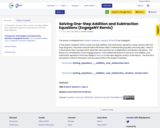
In this lesson, students work to solve one step addition and subtraction equations using mental math and tape diagrams.
- Subject:
- Mathematics
- Patterns, Functions, and Algebra
- Material Type:
- Activity/Lab
- Date Added:
- 12/01/2019

In this lesson, students work to solve one step addition and subtraction equations using mental math and tape diagrams.

Students will analyze a provided math problem with an incorrect answer (bug). Students will demonstrate their understanding of the process by identifying the error, solving the problem correctly and providing an explanation. Math problem solving directly correlates with the step by step process that computer science debugging requires. The purpose of this experience is to provide a jumping off point for a deeper understanding of the Computer Science SOLs. This could be the first time your students are exposed to the vocabulary (algorithm, bug, debugging) and can provide a good foundation of the understanding of the vocabulary in a concrete, low-technology way.

This video is part of the Continue to Know with WHRO TV series. Watch Victoria Valenciana Brannen teach about the order of operations.

This video is part of the Learn and Grow with WHRO TV series. Watch Xenia Claire teach about adding and subtracting with practical problems using a variety of strategies.

This video is part of the Continue to Know with WHRO TV series. Watch Emily Rathbone teach about comprehending word problems using whole numbers.

This video is part of the Continue to Know with WHRO TV series. Watch Ashley Ehret teach about multistep word problems with fractions.

Four in a Row: Fraction Addition and Subtraction Mathematics Instructional Plan

Fraction Riddles: Adding and Subtracting Fractions

Operations with Integers Addition Algebra Readiness Remediation Plan

Estimating and adding to find sums for fractions and mixed numbers with like and unlike denominators. Mathematics Instructional Plans (MIPs) help teachers align instruction with the Mathematics Standards of Learning (SOL) by providing examples of how the knowledge, skills and processes found in the SOL and curriculum framework can be presented to students in the classroom.

Which is Closer? Estimating and Finding Sums of Fractions Mathematics Instructional Plan

Fraction Strips: What is the Meaning of Addition? Mathematics Instructional Plan

This resource is a remix from Illustrative Mathematics.This encourages student collaboration and allows students to have a mathematical dialogue to express their understanding of algebraic properties. This resource is a valuable part of building background when introducing units of measure or equations in the early elementary years of mathematics education as it provides students a concrete example of building an equation with concrete objects. Suggested Modification- Encourage student online portfolio - A student recording sheet with dominos illustrations can be used as a reference for students to have a mathematical dialogue. Teachers can use online educational platforms that would allow students to record their own understanding of math and share them with the teacher. For example, Seasaw is an educational platform that students can use, but will require parental permission. It allows collaboration between teachers, students, and the parent community where students can have a voice and choice in their learning.

Solving single-step practical problems using addition and subtraction with decimals through the thousandths. Mathematics Instructional Plans (MIPs) help teachers align instruction with the Mathematics Standards of Learning (SOL) by providing examples of how the knowledge, skills and processes found in the SOL and curriculum framework can be presented to students in the classroom.

This video is part of the Learn and Grow with WHRO TV series. Watch Shantel Davis teach about related facts.

This video is part of the Continue to Know with WHRO TV series. Watch Emily Rathbone teach about estimating and solving multistep word problems using whole numbers.

Problem Solving using Addition and Subtraction within 20 Formative Assessment - Just in Time Quick Check, Teacher Notes, and Supporting Resources

Addition and Subtraction within 10 Formative Assessment - Just in Time Quick Check, Teacher Notes, and Supporting Resources

Adding and subtracting whole numbers - Mathematics Instructional Plan

The Function Machine Mathematics Instructional Plan